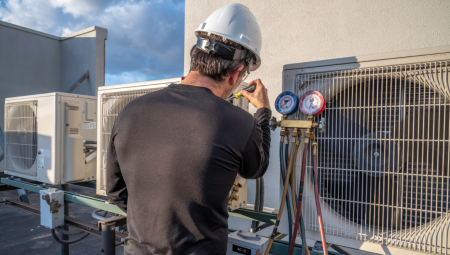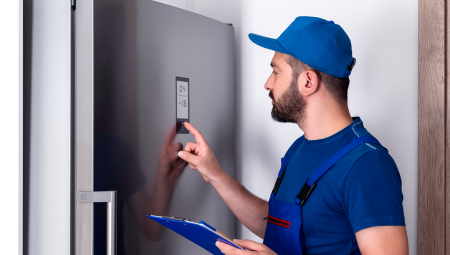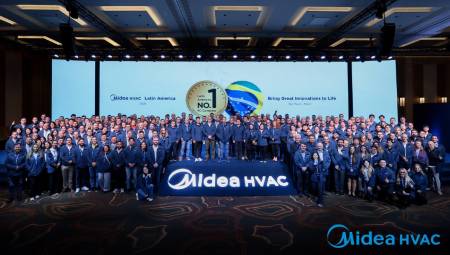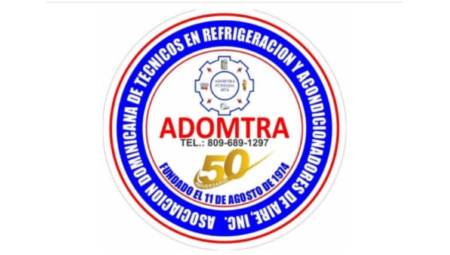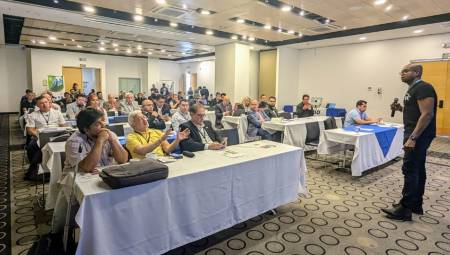 We analyze the true impact of HVAC systems on the spread of the coronavirus and propose control measures in enclosed spaces.
We analyze the true impact of HVAC systems on the spread of the coronavirus and propose control measures in enclosed spaces.
by Mauricio Mathey De Rivero*
Introduction: COVID-19 is a virus that is spread through droplets (small droplets) that an infected person throws into the environment when sneezing, coughing or talking. Given their way of spreading, it is necessary to understand what the impact of HVAC systems is and the measures that can be taken to prevent the spread of the virus through these systems.
Forms of contagion
Before analyzing the alternatives to prevent the spread of the virus through HVAC systems, let's see what are the most common forms of contagion, according to the World Health Organization:
Large droplets (>10 microns)
• Generated when a person coughs or sneezes
• Fall on surfaces 1 or 2 meters away
• Do not remain suspended in the air
• Spread the virus by falling on surfaces that other people then touch
Small droplets (<5 microns)
• Generated when a person coughs, sneezes or talks
• Can travel more than 2 meters away
• They can stay in the air for several hours
• Studies suggest that they spread the virus under certain conditions, such as a large group of people talking very close or in closed environments with poor ventilation
Oral fecal
• This form of contagion is just being studied
• COVID-19 has been detected in fecal samples
• This form of contagion would occur mainly in bathrooms
Impact of HVAC Systems on the Spread of COVID-19
A study published in the journal Emerging Infectious Diseases of the U.S. Centers for Disease Control and Prevention analyzed the contagion of three families who attended the same restaurant with air conditioning. The study specifies that the 3 families sat at nearby tables and one of the people in the three families was infected with COVID-19. The 10 people who made up the three families were infected. In addition, it is mentioned that there were 73 more people in the restaurant, who were not infected.
Additionally, 3 samples were taken from the supply grids and 3 samples from the return grids to analyze if there were traces of COVID 19 in the air conditioning system. The results came back negative.
Although the study has limitations, since the air route of contagion was not simulated nor the probability of contagion of each of the people was calculated, it concludes that air conditioning helped the virus spread to a greater distance.
From this study it can be concluded that the air currents generated by an air conditioning system can have two effects for the spread of COVID 19:
• Can help droplets travel farther
• It could put back into suspension the virus that had already been deposited on a surface
It is important to mention that while this is only a study, so far there is no evidence for or against the spread of the coronavirus through air conditioning or ventilation systems.
Air treatment to prevent the spread of COVID19
In general we could say that there are two methods of cleaning the air and that they are complementary to each other:
A. Filtration of particles and microorganisms
B. Air cleaning by ozone
They are complementary because method B does not filter particles and method A does not destroy or inactivate microorganisms.
It should be clarified at this point that bacteria have a diameter that varies between 0.1 and 5 micrometers (thousandth of a millimeter) while viruses have a diameter of between 10 to 300 nanometers (millionth of a millimeter), that is, they are 1,000 times smaller on average than a bacterium.
A. Filtration of particles and microorganisms
The purpose of cleaning the air is to reach the minimum conditions necessary in a specific environment, which allow the process carried out in it to be carried out in an innocuous way. These processes can be as extreme as those performed in a hospital operating room or as common as those performed in an office building.
Air cleanliness is measured by the amount of particles that can be found in one cubic meter of this air. There are several standards in this regard, including the GMP (Good Manufacturing Practices) that establishes the guidelines for the manufacture of pharmaceutical products, however, as a summary we are only going to refer to a part of the ISO 14644 standard that classifies air quality as follows:

Figure 1.
In order to reach these levels of air cleanliness, filters of different types are used and classified by their effectiveness or MERV. MERV values range from 1 to 20 and the greater the number, the greater the particle retention capacity.
The box on the next page shows this more clearly.
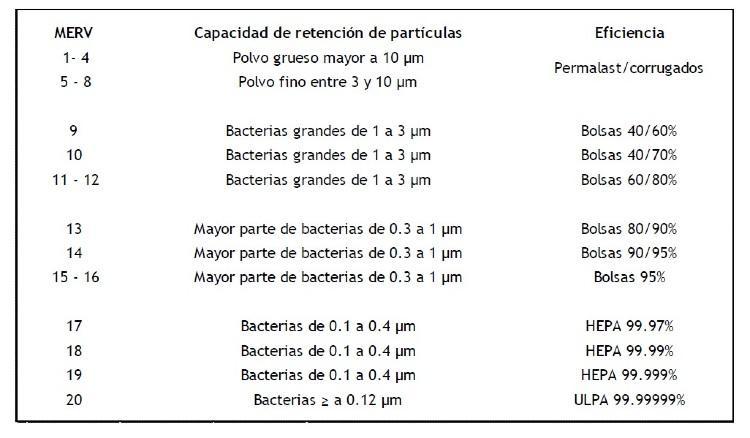
Figure 2.
Let's go into more detail on how HEPA filters work. They are composed of a mesh of glass fibers, randomly ordered and having a diameter of between 0.5 and 2 μm. The space between these fibers is greater than 0.3 μm which does not mean that they cannot retain particles smaller than this diameter.
The retention capacity of these filters acts under 3 mechanisms:
• Interception: particles traveling in the air stream rub against one of the fibers and adhere to it.
• Impact: Larger particles traveling in the air stream cannot avoid the fibers and impact against them.
• Diffusion: smaller particles (less than 0.1 μm) collide with air molecules and adhere to filter fibers by interception or impact.
This is how HEPA filters act by retaining particles, however, those of intermediate size that have a diameter of 0.3 μm are the most penetrating and difficult to retain. That is why these types of filters define their efficiency based on the retention capacity of this particle size.
In conclusion, the methods of cleaning the air by means of filters, do not exterminate bacteria and in the best case only retain them in high efficiency filters and remain alive in these filters until they are replaced by new ones. Also, filters do not have the ability to retain viruses because they are much smaller than bacteria. Therefore, filters are not a viable alternative to prevent the spread of COVID19.
B. Air cleaning by ozone
Ozone (O3) has a germicidal effect and has been shown to be very effective for the extermination of bacteria and deactivation of viruses (ASHRAE Report of 24.6.2009).
Ozone can be generated by two methods:
• By means of a UVC ultraviolet lamp, when oxygen passes in front of these lamps.
• By means of a discharge in a "corona" system, when oxygen passes through an electric field through 2 metal plates.
Both systems have similar electrical consumption and their effectiveness is also similar, however, the UVC lamp system is simpler, requires less service and has a longer service life than the system - approximately one year.
In air conditioning systems, UVC filters are used by installing them very close to the coils of evaporators and drainage trays, where high humidity and low temperatures are conditions conducive to the proliferation of biofilms. These biofilms produce microorganisms that eventually propagate and circulate in air treatment systems.
Viruses are not generated in these biofilms, but they can end up in air treatment systems in several ways, including:
• By a building occupant who is infected and releases the virus within their work zone
• For external pollution through the air or contaminated elements that enter
Some studies indicate that in HVAC systems with a rate of 4 to 6 air changes per hour, UVC lamps can reduce the level of microbiological contamination in the air, to levels below what would affect most people. However, when high rates of pollutant removal are required, an air change level of between 15 and 20 per hour is recommended.
In conclusion, ozone air cleaning methods exterminate bacteria and viruses and their use helps to obtain a new level of air cleanliness that is not achieved with conventional filters.
Conclusions
• Filters are not a viable alternative to prevent the spread of COVID-19 because the virus is much smaller than the particles that the filter is able to filter
• Air cleaning using ozone is a viable alternative; however, this must be combined with air renewal because it is not proven that HVAC systems absorb COVID-19 and therefore if the air is not renewed the virus will remain within the environment.
• While each case should be studied in greater detail, everything seems to indicate that the most cost-efficient way to prevent the spread of COVID-19 through HVAC systems is through good ventilation of environments, air renewal and ideally maintaining a positive pressure to ensure that air leaves the environment. This can be achieved by opening the windows or drastically reducing the percentage of air that is recirculated in the system.
• Ventilation of environments should start before people arrive and end after they have left (ideally 2 hours before and after)
• The renewal of the air (increasing the intake of fresh air and reducing the return) must be accompanied by the reduction of personnel in the spaces to ensure that there is a distance greater than 2 meters and that there is no accumulation of people, this will also help relieve the thermal load of the environment, as the increase in fresh air reduces the capacity of the system
• In the bathrooms it is necessary to ensure the supply of fresh air and also an extraction system that allows to maintain a negative pressure. Also, it is recommended to pull the toilet always with the lid closed.
References
• Federation of European Heating, Ventilation and Air Conditioning Associations. (April 2020). REHVA COVID 19 guidance document, April 3, 2020 . Obtained from federation of European Heating, Ventilation and Air Conditioning Associations.
• Lu, J., Gu , J., Xu , C., Su, W., Lai , Z., Zhou , D., . . . Yang, Z. (July 2020). COVID 19 Outbreak Associated with Air Conditioning in Restaurant, Guangzhou, China, 2020 . Obtained from Emerging Infectious Diseases.
• World Health Organization. ( March 2020). Getting your workplace ready for COVID 19 . Retrieved from World Health Organization
* Mauricio Mathey De Rivero is the CEO of peru-based engineering firm Autorel.






